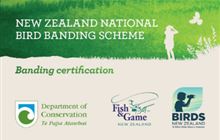Bird bander's code of conduct
Introduction
All banders must adhere to the New Zealand National Bird Banding Scheme's code of conduct.The Bander’s Code of Conduct
Banders must have appropriate certification and permits to conduct their work.
Banders are responsible for the safety and welfare of the birds they study:
- The welfare of the bird is paramount.
- Only catch as many birds as are required for the purpose of your project.
- Handle each bird carefully, gently, quietly, with respect and in the shortest possible time.
- Do not operate more trapping/catching equipment than you can properly manage.
- Capture and process only as many birds as you can safely handle.
- Do not allow unqualified persons to use your equipment, capture or handle birds, or fit bands, except under direct supervision.
- Do not attempt to catch birds in conditions that could result in birds becoming severely stressed, subject to potential injury or death, or lead to birds abandoning occupied nests.
- Birds that show signs of stress should, in most cases, be released without banding.
- Regularly check all mist-nets and traps according to site conditions and target species.
- Properly close all mist-nets and traps at the end of each banding operation.
- Beware of banding nestlings at too advanced an age (they may ‘explode’ from the nest).
- Use the correct band size and banding pliers for each bird.
- Keep careful and accurate records of all birds banded and submit schedules to the Department of Conservation Banding Office.
- Treat all bird injuries in the most humane way.
- Maintain trapping and banding equipment in hygienic conditions (see the Department of Conservation’s Wildlife Health Management Standard Operating Procedure; DOC 2010a).
Banders should continually assess their own work to ensure that it is beyond reproach:
- Look for ways to improve your techniques and advise the Banding Office of improved methods.
- Reassess your methods and approach whenever an injury or mortality occurs.
- Ask for and accept constructive criticism from other banders.
Banders should offer honest and constructive assessment of the work of other banders to help maintain the highest standards possible.
Banders must obtain permission to band on private land and public lands where authorisation is required.
Banders should be willing to explain the methods and purpose of bird banding to members of the public when necessary.
Notes
- The above has been taken from Melville, D.S. 2011: New Zealand National Bird Banding Scheme bird bander’s manual. Department of Conservation, Wellington. 133 p.
- Copies of DOC Standard Operating Procedures can be obtained from the Banding Office.

